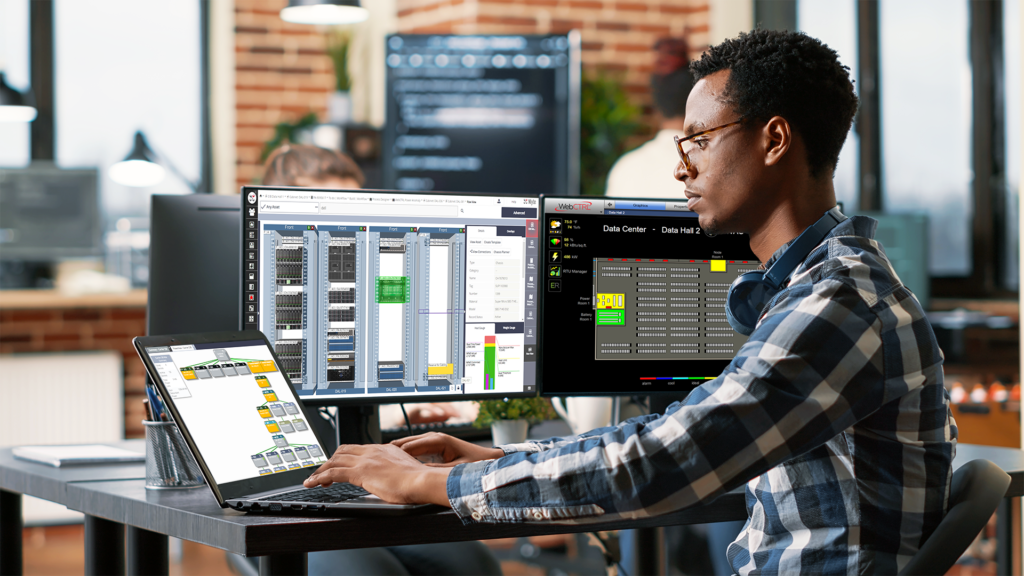Data centers play a critical role in almost every aspect of our lives, from the cloud-based services we use daily to the underlying technology infrastructure supporting them. However, as these facilities grow in size and complexity, so do their energy demands, which puts an immense strain on the environment. Therefore, finding innovative ways to increase energy efficiency and reduce waste is essential. One effective solution is integrating a Building Automation System (BAS) with a Data Center Infrastructure Management System (DCIM) to improve sustainability.
A Building Automation System (BAS) is a centralized control system that manages and controls the environmental conditions of a building, including heating, ventilation, air conditioning (HVAC), lighting, and security. A Data Center Infrastructure Management System (DCIM) is a software solution that provides centralized management and monitoring of a data center’s IT and physical infrastructure. Integrating a BAS with a DCIM creates a powerful tool to optimize the data center’s energy usage, reduce waste, and improve sustainability.
One of the most significant benefits of integrating a BAS with a DCIM is improved energy efficiency. These systems can continuously monitor and analyze the data center’s energy usage and environmental conditions in real time. This enables the BAS to adjust the HVAC, lighting, and other systems to ensure the data center operates at peak efficiency, reducing energy waste and associated costs. The DCIM can also provide critical insights into power usage effectiveness (PUE) and data center infrastructure efficiency (DCiE), enabling data center operators to identify areas for further improvement.
Another advantage of integrating a BAS with a DCIM is improved sustainability. Data centers can significantly reduce their carbon footprint by reducing energy waste and contributing to a more sustainable future. Additionally, integrating the BAS and DCIM can provide real-time data on energy consumption, which can be used to make informed decisions on further improving sustainability efforts.
Furthermore, integrating a BAS with a DCIM can improve overall data center performance and reduce the risk of equipment failure. The BAS can identify potential problems and adjust to avoid downtime by continuously monitoring the data center’s environmental conditions. The DCIM can also provide valuable insights into the data center’s physical infrastructure, such as server utilization and capacity planning, enabling data center operators to make informed decisions on upgrading and maintaining equipment.
In conclusion, integrating a Building Automation System (BAS) with a Data Center Infrastructure Management System (DCIM) is a powerful tool that can significantly improve a data center’s energy efficiency, reduce waste, and improve sustainability. By working together, these systems can provide real-time data on energy usage and environmental conditions, enabling data center operators to make informed decisions on optimizing their facilities’ performance. As the world becomes increasingly dependent on data centers, finding innovative ways to reduce their impact on the environment is crucial, and integrating a BAS with a DCIM is a significant step in that direction.
Additional Resources
Standard 90.4: Energy Standard For Data Centers, February 2023 ASHRAE Journal
Introduction to Integrated Data Center Management (IDCM) – YouTube
Integrated Data Center Management | Nlyte
Integrated Data Center Management | Automated Logic
Data Centers | Carrier Commercial Systems
Data Center Solutions Brochure | Carrier Commercial Systems
Definitions
BAS stands for Building Automation System. It is a centralized control system that manages and controls the environmental conditions of a building, including heating, ventilation, and air conditioning (HVAC), lighting, and security. The BAS uses sensors, actuators, and controllers to automate and optimize the building’s systems, ensuring that they operate at peak efficiency and in a coordinated manner. By monitoring and adjusting the building’s systems in real-time, the BAS can improve energy efficiency, reduce waste, and improve occupant comfort and safety. BAS can be used in a variety of buildings, including commercial, industrial, and residential structures.
DCIM stands for Data Center Infrastructure Management. The software solution provides centralized management and monitoring of a data center’s IT and physical infrastructure. DCIM allows data center operators to monitor, analyze, and manage various aspects of the infrastructure, including power and cooling systems, server utilization, capacity planning, and environmental conditions. DCIM provides a holistic view of the data center’s performance and helps operators make informed decisions on optimizing energy efficiency, reducing waste, and ensuring business continuity. The software typically includes real-time monitoring, reporting, and analysis tools and automation and integration capabilities with other data center systems. DCIM is an essential tool for managing modern data centers that are becoming increasingly complex and demanding regarding energy efficiency, reliability, and sustainability.
HVAC stands for Heating, Ventilation, and Air Conditioning. It refers to the systems used to control and regulate indoor environments’ temperature, humidity, and air quality, such as buildings, homes, and vehicles. HVAC systems typically have several components, including heating and cooling units, air ducts, air filters, and thermostats. These systems work together to maintain comfortable and healthy indoor conditions by heating or cooling the air and circulating it throughout the building. Properly functioning HVAC systems are essential for maintaining indoor air quality, preventing the spread of airborne pollutants, and ensuring occupant comfort and safety.
DCiE stands for Data Center infrastructure Efficiency. It is a metric used to measure the energy efficiency of a data center. DCiE is calculated by dividing the IT equipment power consumption by the total power consumption of the data center, including cooling, lighting, and other support systems. The resulting number represents the percentage of energy that is used by the IT equipment compared to the total energy consumed by the data center. The higher the DCiE, the more energy-efficient the data center is. DCiE is a helpful metric for data center operators to track and optimize their energy usage, reduce costs, and improve sustainability.
An example of how to calculate DCiE:
Suppose you have a data center with a total power consumption of 1000 kW, and the IT equipment power consumption is 600 kW.
DCiE = IT equipment power consumption / Total power consumption
DCiE = 600 kW / 1000 kW
DCiE = 0.6 or 60%
In this example, the DCiE of the data center is 60%, which means that the IT equipment uses 60% of the energy consumed by the data center, and the remaining 40% is consumed by cooling, lighting, and other support systems. By tracking and optimizing DCiE, data center operators can identify areas for improvement and implement energy-efficient solutions to reduce costs and improve sustainability.
PUE stands for Power Usage Effectiveness. It is a metric used to measure the energy efficiency of a data center. PUE is calculated by dividing a data center’s total power consumption by the IT equipment’s power consumption alone. The resulting number represents the ratio of the total energy used by the data center to the energy used by the IT equipment. The lower the PUE, the more energy-efficient the data center is.
An example of how to calculate PUE:
Suppose you have a data center with a total power consumption of 1000 kW, and the IT equipment power consumption is 600 kW.
PUE = Total power consumption / IT equipment power consumption
PUE = 1000 kW / 600 kW
PUE = 1.67
In this example, the PUE of the data center is 1.67, which means that for every watt of power used by the IT equipment, 1.67 watts of power are consumed by the data center’s support systems, such as cooling, lighting, and power distribution. By tracking and optimizing PUE, data center operators can identify areas for improvement and implement energy-efficient solutions to reduce costs and improve sustainability.




4 Responses